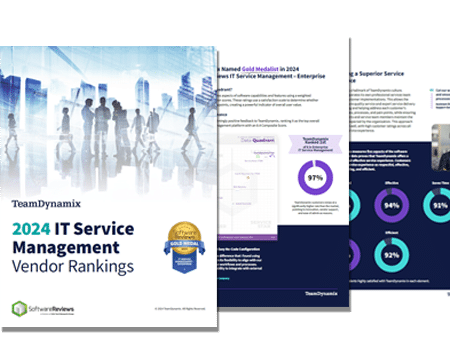
Enterprise Service Management: Why a Unified Platform Matters
Enterprise Service Management (ESM) is the practice of extending IT Service Management (ITSM) principles beyond the IT department to other areas of an organization. ESM

The Info-Tech ranking report offers a unique view of the market based entirely on in-depth customer interviews. Download the Info-Tech ITSM Quadrant and Customer Viewpoint report today.

We’ll show you some of our best situations and show you exactly how to execute them to get immediate results. The best part is, iPaaS tools often feature easy-to-use click and drag functionality, meaning you don’t need a dedicated employee building integrations and workflows.

System Integrators, Value Added Resellers, Technology Providers, and Buying Consortiums can benefit from a partnership with TeamDynamix.

The Info-Tech ranking report offers a unique view of the market based entirely on in-depth customer interviews. Download the Info-Tech ITSM Quadrant and Customer Viewpoint report to gain a better understanding of key vendor strengths and emerging market requirements.
As an IT leader, having a solid understanding of the principles of ITIL (Information Technology Infrastructure Library) is essential for developing and growing your organization’s operations. This framework provides an organized approach to service management that helps define and standardize processes related to technology infrastructure, such as data storage, cloud computing, mobility solutions, and more.
Specifically, ITIL can help organizations streamline their operations by creating standardized procedures for the efficient delivery of services and ensuring best practices are followed in all departments. Furthermore, it promotes continuous improvement through feedback loops that measure employee performance, customer satisfaction and overall system efficiency. Lastly, it enables better decision-making by providing structured guidance on areas such as choosing vendors, setting realistic SLAs for each service and implementing change management plans.
Having a good grasp of the fundamentals of ITIL can have far-reaching benefits for an organization. With its widespread presence across industries worldwide, understanding this vital framework is now seen as necessary for mature, successful IT departments.
ITIL is a collection of best practices intended to help IT services be managed more efficiently. These guidelines define a process-based approach to the management and the continuous improvement of information technologies and services.
ITIL 4 provides organizations with the guidance they need to address new IT Service Management (ITSM) challenges and harness the potential of modern technologies in the age of cloud, agile and DevOps transformations. A vital component of the ITIL 4 framework is the use of a single, uniform and cohesive set of guidelines for the management of IT services.
Interest in the adoption of ITIL continues to grow, and the most recent version of ITIL, ITIL 4, was released in 2020.
While the underlying practices generally remain the same as before, the most updated version focuses on “value co-creation” with clients, creating more engagement when it comes to client collaboration. The methodology has also positioned itself to be more of an integration platform between other processes and methodologies (project/portfolio management, etc.).
The Foundation is currently in the process of implementing an entry-level ITIL 4.0 certification to introduce the key elements, concepts, and terminologies used in ITIL. Managed by the International IT Management Association (ITMA) and the IT Service Management Foundation, the Professional Stream is geared towards IT professionals and digital teams working in corporate technology. The focus is on the development and implementation of IT service management and information management systems, as well as the implementation and management of information security.
The most recent release, ITIL 4.0, is the first significant update of ITIL since 2007 and arguably the most critical update in the history of the IT Service Management Framework. It modernizes the framework by adopting a holistic approach to service management and focusing on end-to-end management with on-demand value. It provides a flexible basis to support the expansion and implementation of information management and information security systems on a scalable basis. ITIL 4.0 has been described as “the next generation of technology-enabled products for the IT service management industry.”
The ITIL framework bases itself on five phases of the service life cycle, with the leading publications providing best practices and guidelines for each stage. The guidelines set out the necessary processes, associated challenges, and best practices for each phase of the service life cycle, as well as the requirements for the implementation of each phase.
With an understanding of the ITIL framework and how it can be used to improve the quality of ITSM in an organization, IT professionals can change their organizations for the better.
Those who have implemented and adapted ITIL need to be informed about the control of information security, IT management, and information management. Being well-informed fits the organization’s desire to establish, implement, maintain and continuously improve the service management system.
If you’re looking to build a strong ITSM foundation with ITIL, you can try these four key tips:
Many institutions are implementing ITIL to ensure they have a common vocabulary and methodology surrounding request fulfillment and incident response.
Increased demands for online and blended learning experiences put pressure on higher-ed IT organizations, but IT budgets are staying static or even decreasing.
TeamDynamix ITSM makes a positive impact when paired with ITIL in higher education. Yancy Philips, IT Team Director for Indiana State University, explained how their old basic ticketing system that was used to manage the delivery of IT service “served its purpose for many years, but as we started to adopt more ITIL best practices and worked to improve our service delivery, we knew we needed something more.”
That something more was TeamDynamix.
“People are thrilled with our service now,” Philips says.
Likewise, in an ever-connected world, state and local governments need to provide new services and keep up with changing needs while often balancing tight budgets.
Implementing ITSM best practices enables organizations to standardize and optimize the way they respond to the ever-increasing demand while keeping operational costs low and customer satisfaction high.
Dusty Borchardt, Business Systems Manager for Oklahoma City, said that they adopted the ITIL framework more than 15 years ago. He explains that they’d had effective processes in place for a while, but they “haven’t had a decent toolset to manage them” until they utilized TeamDynamix’s ITSM platform.
“TeamDynamix has brought simplicity to our operations,” Borchardt says. “This is the first IT Service Management platform we’ve implemented that everyone loves to use.”
Whether you’ve been using ITIL for years or are just starting, the right ITSM tool makes a difference.
The City of Goodyear recently switched to TeamDynamix for ITSM to address their lack of ITIL maturity and growing workloads.
“It’s one thing to say we’re overworked—and it’s another to be able to illustrate this with concrete data,” said Lisa Faison, deputy CIO for the City of Goodyear, Arizona, municipal government.
A few years ago, the City of Goodyear didn’t have any way to track the status of IT projects. The city government had a ticketing system for managing the delivery of IT services, but this system was very limited in what it could do and what information it could provide.
“We wanted to increase the maturity of our IT operations by moving to ITIL processes,” Faison said.
This meant bringing the oversight of IT services and projects together under a single platform for IT Service Management (ITSM) and Project Portfolio Management (PPM) to give leaders a holistic view of the work employees were doing. What’s more, the platform had to allow for simple configuration and automation of IT processes, without a lot of coding or administration needed on the back end.
One year into using TeamDynamix, having better visibility into project and service information has helped the city’s IT department improve customer service for employees—and the city has only begun to scratch the surface of what the platform enables.
As Goodyear’s IT maturity continues, Faison and her colleagues will be looking to use the data they collect on IT projects to accurately forecast the amount of time that new projects will take, so they can allocate resources to projects more effectively. They also plan to help other city departments use TeamDynamix for enterprise-level service and project management.
Want to learn more about ITIL? Read 4 ITIL Best Practices to Revive Your Service Management.
This blog was originally published in May 2020 and has been updated with added information.

Enterprise Service Management (ESM) is the practice of extending IT Service Management (ITSM) principles beyond the IT department to other areas of an organization. ESM

As businesses grow, so does the complexity of managing their services. This is where Enterprise Service Management (ESM) comes in, offering a structured approach to

As IT departments modernize their service management tech stacks, automation stands out as a pivotal force driving significant transformations in how the IT service desk
TeamDynamix’s award-winning SaaS cloud solution offers IT Service and Project Management together on one platform with enterprise integration and automation.
[email protected]
(877) 752-6196
Contact Us
